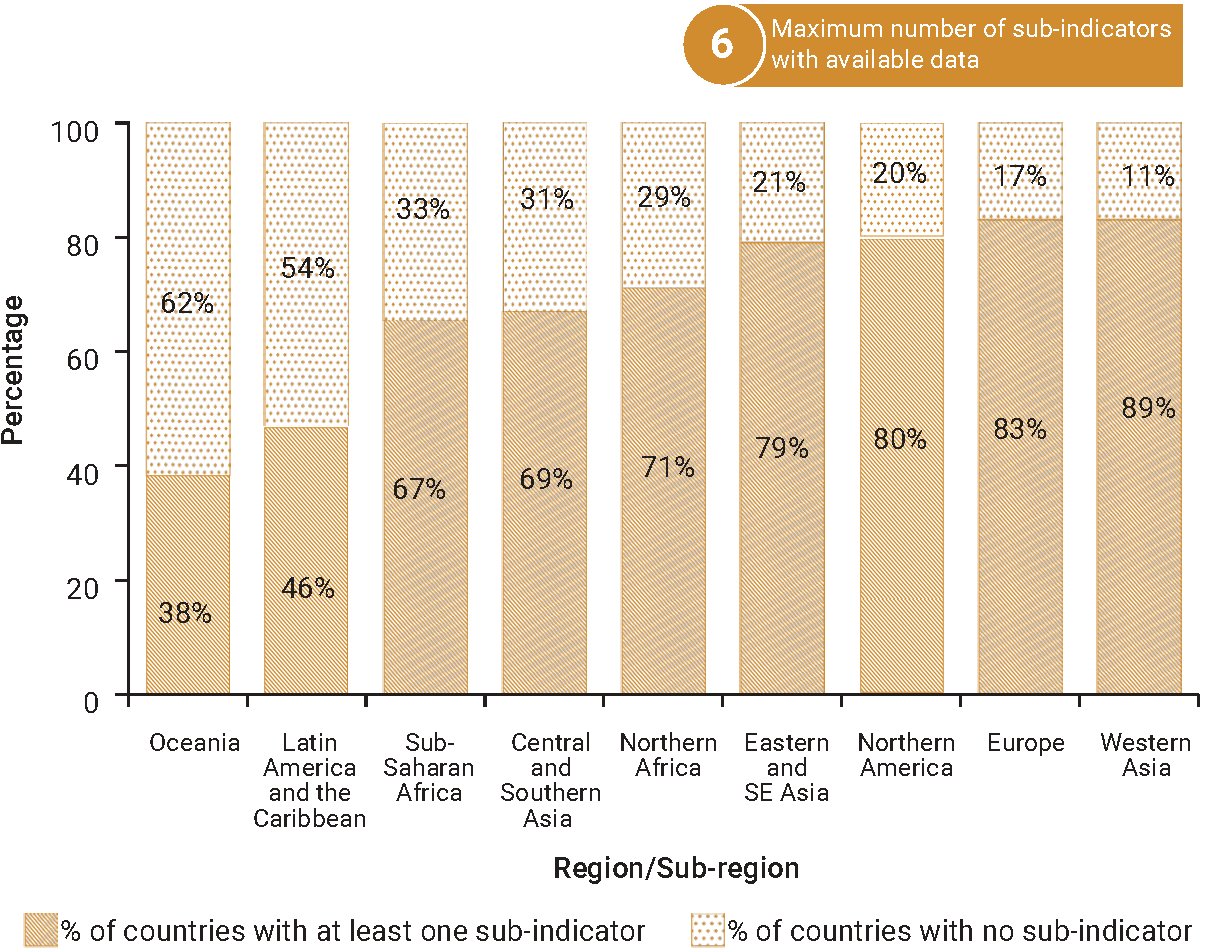SDG Indicator 6.3.1: Proportion of domestic and industrial wastewater flows safely treated
1. Key features and metadata
Definition: This indicator tracks the proportion of wastewater flows from households, services and industrial economic activities that are safely treated at the source or through centralized wastewater treatment plants before being discharged into the environment, out of the total volume of wastewater generated.
| Sub-indicator | Disaggregated by |
|---|---|
|
EN_WWT_GEN Total wastewater generated (million m3/year) |
Activity (e.g. industries, agriculture, forestry and fishing) Location (urban/all areas) |
|
EN_WWT_TREAT Total wastewater treated (million m3/year) |
Activity (industries, total)
|
|
EN_WWT_TREATR Proportion of wastewater treated, by activity and location (%) |
|
|
EN_WWT_WWDS Proportion of safely treated domestic wastewater flows (%) |
No current data disaggregation available. |
Sources of information: Data is commonly collected by national line ministries and institutions (e.g. Water, Sanitation, Environment, Health, Public Services, Planning, Housing, Infrastructure, or Production), utilities and on-site service providers, and the National Statistical Office (household surveys and registers of economic activities).
Related SDG Indicators: 6.2.1(a) (Proportion of population using safely managed sanitation services), 6.3.2 (Proportion of bodies of water with good ambient water quality), 6.6.1 (Change in the extent of water-related ecosystems over time) and 14.1.1(a) (Index of coastal eutrophication).
2. Data availability by region, SDG Global Database, as of 02 July 2025

3. Proposed disaggregation, links to policymaking and its impact
| Proposed disaggregation | Link to policymaking | Impact |
|---|---|---|
|
Total wastewater generated by activity (million m3/yr) (United Nations [UN] 2008; United Nations Human Settlements Programme [UN-Habitat] 2018a):
Applies to:
|
This disaggregation provides information onwastewater quantities by main wastewater generators to enable informed decision-making in relation to the enforcement of regulation (e.g. discharge permits) and wastewater management (e.g. elimination of hot spots) at both the national and local levels(UN-Habitat 2018a). Differentiating between different wastewater sources is necessary to identify the main generators and related challenges, and to guide decision-makers in their planning and investment choices. It is also necessary to apply the "polluter pays" principle, which helps to incentivize a high level of wastewater treatment, to enforce water quality regulation and to support the economic sustainability of the sector(UN-Habitat and WHO 2021). Integrated water resources management is the appropriate tool to implement comprehensive, equitable and sustainable water policy, of which wastewater management is an integral part(UN-Habitat and WHO 2021). This disaggregation contributes to the UN Water Action Decade (UNGA 2017b) and the SDG 6 Global Acceleration Framework(UN-Water 2020) |
Reducing untreated wastewater streams, regardless of the source, contributes to minimizing the spread of pathogens as well as emissions of nutrients and harmful substances in waterbodies and reduces the spread of adverse health effects. In turn, improving the quality of water helps to address other essential development issues such as food production, industrial and energy development, tourism and water-related leisure (e.g. bathing water) and the growing demand for water. Mitigating untreated wastewater is also central to the development of adaptation strategies and policies to increase society's resilience to climate change(UN-Habitat and WHO 2021) |
|
Proportion of wastewater by place of discharge(%):
|
This disaggregation provides valuable information on the origin of the discharge of wastewater and allows monitoring of the place of discharge and its surroundings to identify the impact on water ecosystems (i.e. surface water, coastal or marine). Its data equips policymakers with the necessary information to develop targeted policies to address land and water pollution, plan for wastewater treatment plants to protect the health of surrounding communities and species, and hence create job opportunities(World Water Assessment Programme [WWAP] 2017). It applies the principles and best practices of integrated water resource management (IWRM) and contributes to the UN Water Action Decade(UNGA 2017b) and the SDG 6 Global Acceleration Framework(UN-Water 2020). |
An improved understanding of where wastewater is discharged has a significant impact on the quality of water bodies and hence ecosystems. In addition, treated wastewater is beneficial for resource efficiency and extraction. Less freshwater is needed for consumption where treated wastewater is used. Wastewater treatment, being an essential component in the shift towards a circular economy, can generate new business opportunities and be beneficial for the surrounding communities’ health and well-being(WWAP 2017). |
|
Proportion of wastewater treated by level of treatment (%)(UN-Habitat 2018a; UNSD 2022; FAO n.d.a):
Applies to:
|
Secondary or tertiary treatments are used as a proxy for safe wastewater treatment. Tracking the proportion of wastewater treatment by level of treatment is essential for providing timely information to decision-makers and stakeholders to monitor and control this source of pollution and its potential impacts on drinking water and water bodies. This accelerates progress towards increasing wastewater treatment. In addition, it enhances communities’ awareness regarding the quality of their environment and helps increase accountability from national or local governments and water authorities.It contributes to the UN Water Action Decade(UNGA 2017b) and the SDG 6 Global Acceleration Framework(UN-Water 2020). |
Increased amounts of untreated wastewater lead to water contamination by various categories of substances that affect both water quality and availability. It is also a major cause of concern for the population’s health. Significant quantities of untreated wastewater are disposed in the ecosystem, resulting in about 1.8 billion people using contaminated water with faeces(UN-Habitat 2018a). By reducing pollution loads into aquatic ecosystems, the safe treatment of wastewater is a major source of improvement for human health, living conditions and the environment. It is also key in facing the growing demand for water of good sanitary and ecological quality. |

